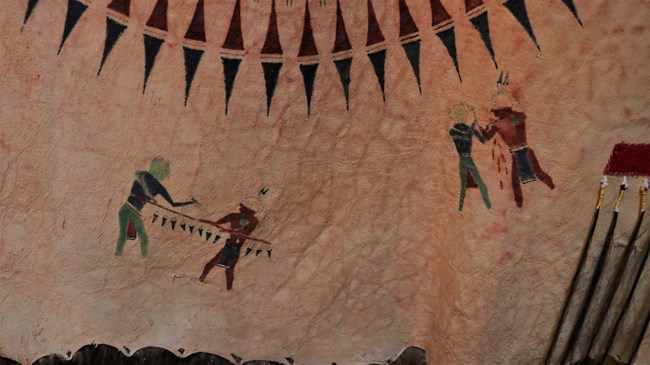
NPS Staff Four Bears Exploit RobeHistory of the RobeThis is the reproduction of the Four Bears Exploit robe which was painted by Mato-tope, or Four Bears (1784-1837), a great second chief of the Mandan village of Mitutanka. The robe depicts the greatest achievements throughout Four Bears’ life and was made in 1835.The original robe is currently in the Bern Historical Museum in Switzerland and was made in 1835. It was possibly gifted to either George Catlin or Karl Bodmer in the 1830’s. Bodmer/Maximillian and Catlin were both given robes by Four Bears. Both created copies of the robes. It is unclear if this is a replica of one of those robes. SymbolsThe locks of hair hanging from the robe would have come from scalpings, but the current locks on the robe are made from horse hair. These represent that Four Bears had more than seven successful war parties where enemies were killed.Meaning behind the red and blue circles near each of these is unknown.The center black and red triangles represents eagle feathers and the warrior spirit, as well as the sun shining and the back of war bonnet, in this case, Four Bears’. This was also a common decorative style among Plains Native Americans, called the feather and circle pattern. The circles in the center are believed to be a village surrounded by smoking tepees. The Stories
NPS Staff Fight with a Cheyenne ChiefTwo stories are in this picture. Starting with the picture on the left, Four Bears is the figure on the right. Eagle feathers are in his hair, and his mouth and body are painted red. He uses his lance hung with eagle feathers to strike and kill a Cheyenne chief who had sent word that he wanted to fight.Cheyenne Chief With The KnifeOn the far right is the famous battle Four Bears had with a Cheyenne chief.The chief challenged Four Bears to combat with rifles and horses. When Four Bears’ powder horn was shot away, the two turned to bows and arrows until they ran out of arrows. Both dismounted and turned to hand-to-hand combat.The Cheyenne chief drew his knife during the struggle, and Four Bears was cut across the hand multiple times while wrestling it away from him. Four Bears can be seen bleeding from his hand in the picture. Ultimately Four Bears obtained the blade and killed the Cheyenne chief with his own knife. This fight took place in front of many Mandan and Cheyenne. Four Bears later wore a small knife on his headdress as a reminder of the fight. 
NPS Staff Round HeadsA large group of Assiniboine entrenched in a defensive position near a Mandan village, as shown by the round heads at the corner of the robe.ScalpingsThe heads at the top right represent enemies killed and scalped by Four Bears.Fleeing AssiniboineIn black paint here, Four Bears wears an eagle feather in his hair and a red military sash over his shoulder.In Four Bears’ left hand is his flintlock, which was fired and hit a fleeing Assiniboine’s shoulder. This Assiniboine had previously shot at Four Bears, but his gun burst and is lying on the ground. Wounded Four BearsFour Bears is the green figure here, wearing an eagle feather trailer and leggings that are red on the inside and horizontally striped on the outside. After being left by his party, badly wounded and bleeding, Four Bears killed a Cheyenne chief. You can also see the bullets from the Cheyennes’ guns flying all around Four Bears, and the Cheyenne chief below him. 
NPS Staff Powder Horn (Cheyenne Chief with Knife 2)While battling with a “Shienne” or Cheyenne chief, Four Bears’ powder horn was shattered by his adversary, and his ammunition was destroyed. He threw it and his gun from him, and the Cheyenne. A war party of Cheyenne watched nearby, which is represented by the row of dots. This is very likely connected to Four Bears' previously mentioned battle with a Cheyenne chief in which he killed the Cheyenne chief with the chief's own knife. 
NPS Staff Four Bears' NameMato-tope earned the name Four Bears here. Four Bears is represented by a single figure wearing red paint and holding his eagle feather shield and lance. The foot tracks of the enemy are in front of him, the scattered tracks of his own party are behind him, and a shower of bullets fly around his head. Several hundred Hidatsa and Mandan were attacked by a party of Assiniboine, and all but Four Bears fled. Four Bears fired and killed one of the enemy, sending the rest into flight. He also drove off 60 horses which is not depicted. Four Bears got his name from this battle as the Assiniboine said that he rushed like four bears. 
NPS Staff Two WomenFour Bears is shown here in his eagle plume headdress as he leads his war-horse, which carries his large red shield. His horse also wears a crest of eagle plumes. As revenge to a murder, Four Bears sought out an Ojibwa village and waited for six days without sustenance. Eventually two women went to the river for water. Four Bears killed them in full view of the tribe, and his successful escape entitled him to the credit of a victory. 
NPS Staff Cheyenne Chief and WifeA Cheyenne chief with a long eagle feather war headdress and a shield trimmed with eagle feathers are lying on the ground next to his horse. During this fight the Cheyenne's wife bravely rushed forward to help her husband and was also killed. ReferencesThe majority of this information has been compiled from "Visions of the People: A Pictorial History of Plains Indian Life" by Maurer, Evan M., and Louise Lincoln, and "Plains Indian Painting" by John Canfield Ewers. |
Last updated: October 3, 2020
